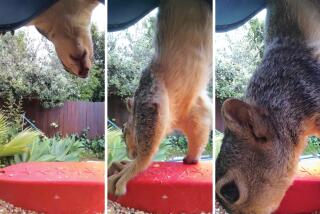Vigilance Is Best Way to Overtake Snails’ Pace
- Share via
Question: What is the best way to control snails and slugs, and is it safe to use snail bait around my vegetables and citrus trees?
R.B., San Juan Capistrano
Answer: Each adult snail can lay 80 eggs as often as six times per year, so control requires continued vigilance. Snails and slugs feed on both living and decaying plant material. Leaves will have irregular holes with smooth edges, and new fruit and young plant bark can be damaged as well.
Snails like tender foliage, young seedlings, herbaceous plants and ripening fruit that grows near the ground. They have also been known to feed on avocado and citrus foliage and fruit.
To announce their presence, snails and slugs leave a silvery slime trail.
Controlling snails and slug involves keeping the following tips in mind:
* Eliminate all hiding places where snails and slugs might take refuge during the day. These areas include under old boards, stones, debris, weedy areas around tree trunks, dense ground covers, and leafy, low-growing branches.
Daily monitoring of hard-to-control places, hand-picking and disposal are important until their numbers are significantly decreased; then weekly inspections are OK.
* Avoid over-watering. Irrigate early in the day so things dry out by evening.
* Place 12-inch-square wood pieces that are elevated an inch or so off the ground in favorite hiding places to trap and collect snails. Check under the boards daily the first week and every other day the second week, every three to four days the third week, and weekly thereafter.
* Place copper barriers around planter boxes and trunks. Snails and slugs are unable to cross copper. Prune the tree’s lower branches and foliage 24-30 inches above the ground to avoid allowing the snails and slugs an alternate route into your trees.
* A bordeaux mixture brushed on the trunk can be used to repel snails. Consult a California Certified Nursery professional at a nursery for specific instructions.
* Predatory decollate snails (Rumina decollate) can be released to control young and half-grown brown snails, but keep in mind that they take years to become established and can feed on young, tender seedlings, small plants and flowers.
* As for baits, remember it’s toxic to decollate snails as well as pets and children. Using the above methods should reduce snail and slug populations enough so you won’t require chemical control.
If you do choose to use bait, follow the package directions carefully.
Call the hotline ([714] 708-1646) for a pest note on this topic.
Have a problem in your yard? University of California Cooperative Extension (UCCE) Master Gardeners are here to help. These trained and certified horticultural volunteers are dedicated to extending research-based, scientifically accurate information to the public about home horticulture and pest management. They are involved with a variety of outreach programs, including the UCCE Master Garden hotline, which provides answers to specific questions. You can reach the hotline at (714) 708-1646 or send e-mail to [email protected]. Calls and e-mail are picked up daily and are generally returned within two to three days.
